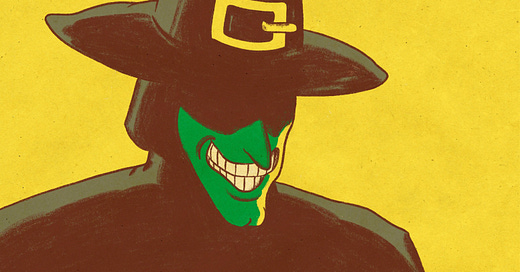Witchman was developed by Tom Scioli to fit into the Golden Age of comic book heroes and to that end, it is supremely successful. There is a rapidity and near unpredictability (maybe randomness is a better word) to the story that emulates the comics of the 1940s and 1950s perfectly, especially the early appearances of the great comic heroes. While this isn’t an obscenely long story by any means, it feels like it is trying very hard to cover a lot of ground all at once and for no reason other than that’s what comics did in the 40s. But this is the first major difference between Witchman and the Golden Age heroes: while the first appearance of Batman ran for six pages and Superman for 13, Witchman covers 52 pages.
The story is the great tragedy of this book. It exists in this space of creators and readers who are pushing against the decompressed, everything must be six issues trend of contemporary comics, and against the “I’ll wait for the trade to come out” mentality that got us here in the first place. But it is also an unintended advocate for longer storytelling, something that Scioli happens to do quite well with (American Barbarian and his biographies of Jack Kirby and Stan Lee are proof enough of this.) In the same way that the plot is told at double speed, the dialogue also lacks much depth. It is almost entirely expositional, moving the plot along at breakneck speeds or otherwise explaining what the art is showing.
Scioli’s art exists in some sort of liminal space, in the best possible ways. As he has drifted further from the Kirbyisms that dominated his earlier work, his style has become very uniquely his own. His art, with its sparse backgrounds and the digital inks and colors, has a sort of outsider feel to it. It is the magical simplicity of his art and design that draws me to it, and to that end, Scioli never fails. The colors very much feel of the period he is hearkening back to, perhaps using a DC color palette from the era. Throughout, there are subtle homages to Batman (a gunfight in the stairwell, a la Year One is particularly good). The titular character’s relationship with the book’s damsel—Santique L’Rose—would not be out of place when swapped with Superman and Lois Lane. The Golden Age tropes might be impossible to ignore, but they are charming to look at. The art alone makes it worth the cost of admission.
Witchman is an enigma. It feels like a pilot episode, introducing every idea that would carry a series through to its completion. Simultaneously, it exists as a perfect homage to the comics that inspired it. But it’s sometimes too hard to know which one was the goal.





